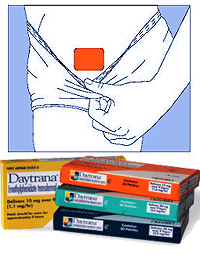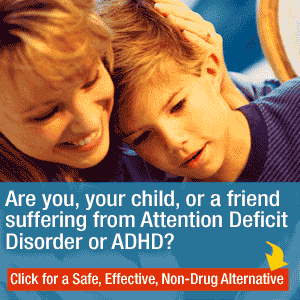Many think methylphenidate (Daytrana) is safe, or mild, because so many children use it. However, the government classifies the psychoactive drug with cocaine and morphine because it is highly addictive.
Daytrana Side Effects and Warnings
Updated November 16, 2018
- Brand Name: DAYTRANA
- Generic Names: methylphenidate transdermal system, methylphenidate film, patch (transdermal)
- Category: CEREBRAL STIMULANTS
Daytrana is methylphenidate, which is an amphetamine-like prescription stimulant commonly used to treat Attention Deficit Hyperactivity Disorder (ADHD) in children (ages 6-12) and adolescents (ages 13-17).
FDA “Black Box” Warning Label
The Food and Drug Administration (FDA) requires the following "black box" warning for Daytrana, which means medical studies indicate that Daytrana carries a significant risk of serious, or even life-threatening, adverse effects.
WARNING: DRUG DEPENDENCE
Important:
Daytrana is a controlled substance (CII) because it can be abused or lead to dependence. Keep Daytrana in a safe place to protect it from theft. Selling or giving away Daytrana may harm others and is against the law.
Tell your doctor if you have ever abused or been dependent on alcohol, prescription medicine or street drugs.
Daytrana should be given cautiously to patients with a history of drug dependence or alcoholism. Chronic abusive use can lead to marked tolerance and psychological dependence with varying degrees of abnormal behavior.
ABOVE: FDA black box warning label means that medical studies indicate the drug carries a significant risk of serious or even life-threatening adverse effects. The bold warning label appears on the manufacturer's wholesale packaging and is the strongest alert the FDA can require of drug-makers.
Available Dosages/Strengths of Daytrana (methylphenidate patch)
Active Ingredient |
Strength |
| methylphenidate |
10 mg/9-HOUR (1.1 mg per hour) |
| methylphenidate |
15 mg/9-HOUR (1.6 mg per hour) |
| methylphenidate |
20 mg/9-HOUR (2.2 mg per hour) |
| methylphenidate |
30 mg/9-HOUR (3.3 mg per hour) |
Used For
- Attention Deficit Hyperactivity Disorder in children (ages 6-12) and adolescents (ages 13-17).
How Daytrana (Methylphenidate) Works
We don't know exactly why it produces the effects it does. Methylphenidate was first synthesized in 1944 in an (unsuccessful) attempt to create a stimulant that would not induce addiction or tolerance. Daytrana is very closely related to amphetamine: similar in chemical structure, metabolization and clinical effects. This close connection is the chief reason Daytrana use raises concern among patients and others.
U.S. DEPT. OF JUSTICE: “Of particular concern is that ADHD literature prepared for public consumption does not address the potential or actual abuse of methylphenidate. Instead, methylphenidate (Daytrana) is routinely portrayed as a benign, mild substance that is not associated with abuse or serious side effects. In reality, however, the scientific literature indicates that methylphenidate (Daytrana) shares the same abuse potential as other Schedule II stimulants. Further, case reports document that methylphenidate (Daytrana) abuse can lead to tolerance and severe psychological dependence.”
How should I use Daytrana?
Use Daytrana exactly as your doctor tells you to.
- Your doctor may change your dose if needed.
- Apply Daytrana to your hip 2 hours before an effect is needed.
-
Do not wear Daytrana longer than 9 hours a day.
- Apply Daytrana to a different hip each day
- Do not cut Daytrana patches.
- Parents or caregivers should apply and remove Daytrana for their child if the
child is not responsible enough to do so
- Your doctor may stop Daytrana treatment to check your ADHD symptoms. Your doctor may do certain blood tests and check your heart and blood pressure while you use Daytrana.
- If you forget to apply a patch in the morning, you may apply the patch later in the day. You should remove your patch at the usual time of day to lower the chance of side effects later in the day.
- If you have loss of appetite or trouble sleeping in the evening, ask your doctor if you can take the patch off earlier in the day.
- Contact with water while bathing, swimming, or showering can make the patch not stick well or make it fall off. If your patch falls off, do not touch the sticky side of the patch with your fingers. You may apply a new patch toa different area on the same hip. If you have to replace a patch that has fallen off, the total wear time for the first and second patch should not be more than a total of 9 hours in 1 day. Do not reapply the same patch that fell off.
If you wear Daytrana longer than 9 hours, or if you wear more than 1 patch at a time, you have used too much Daytrana. Remove all Daytrana patches and wash the application sites right away.
Call your local poison control center or go to the nearest hospital emergency room right away if you have:
-
vomiting
-
agitation
-
shaking
-
confusion or mental changes
-
see things that are not there (hallucinations)
-
sweating
-
redness in your face
-
headache
-
heartbeat changes
Do Not Use If
You have high blood pressure or any form of heart disease, are very nervous or have severe insomnia, have a history of addiction to drugs or alcohol. Do not combine with monoamine oxidase inhibitors.
Common Side Effects
- Addiction
- Nervousness including agitation, anxiety and irritability
- Trouble sleeping (insomnia)
- Decreased appetite
- Headache
- Stomach ache
- Nausea
- Dizziness
- Heart palpitations
Other Serious Side Effects Include
- slowing of growth (height and weight) in children
- seizures, mainly in patients with a history of seizures
- eyesight changes or blurred vision
Less Common Side Effects
- High blood pressure
- Rapid pulse rate (and other heart problems)
- Tolerance (constant need to raise the dose)
- Feelings of suspicion and paranoia
- Visual hallucinations (seeing things that are not there)
- Depression
- Cocaine craving
- Dermatoses (infected or diseased skin)
- Urinary tract infection
- Infection or viral infection
- Elevated ALT enzyme levels in the blood (signaling liver damage)
FDA Warning: Links Between ADHD Drugs and Priapism and Sexual Dysfunction
In a recent drug-safety announcement, the FDA announced that drugs containing methylphenidate must including warnings about the risk of priapism. (Methylphenidate drugs include: Concerta, Daytrana, Focalin, Metadate, Methylin, Quillivant, and Ritalin.) It's a serious problem: priapism is a persistent, usually painful, erection that lasts for more than four hours and occurs without sexual stimulation. If the condition is not treated immediately, it can lead to scarring and permanent erectile dysfunction.
The FDA included an even stronger warning about atomoxetine (Strattera): “Priapism appears to be more common in patients taking atomoxetine than in patients taking methylphenidate products. Health care professionals should be cautious when considering changing patients from methylphenidate to atomoxetine.”
The safety warning also raised concerns about links between priapism and amphetamine drugs, which include Adderall, Dexedrine, ProCentra and Vyvanse.
ABOVE: U.S. FDA Drug Safety Communication: FDA warns of rare risk of long-lasting erections in males taking methylphenidate ADHD medications and has approved label changes. (12/17/2013).
Overdose Side Effects
Methylphenidate drugs have been extensively abused. Extreme psychological dependence and severe social disability have resulted. Abuse of methylphenidate drugs may cause a sudden heart attack even in those with no signs of heart disease. Symptoms of overdose that require immediate medical assistance include:
- Restlessness
- Tremor
- Aggression
- Hallucinations
- Panic states
- Hyperreflexia (overactive reflexes, which can include twitching or spasms)
- Personality changes
- Symptoms of depression
- Seizures or abnormal EEGs
- High blood pressure
- Rapid heart beat
- Swelling of hands/feet/ankles (for example, numbing of the fingertips)
- Delusions
- Sweating
- Vomiting
- Dehydration
- Unexplained muscle pain
- Lower abdominal pain
- Rhabdomyolysis and kidney damage
- Chronic abuse can manifest itself as psychosis, often indistinguishable from schizophrenia
What to Do About Side Effects
The last dose of the drug every day should be taken several hours before bedtime to prevent insomnia.
Nervousness usually goes away and appetite often returns so that weight loss is rarely dangerous.
If high blood pressure, rapid pulse, paranoia, or tolerance becomes a problem, the drug is usually stopped.
Nothing can be done about the addiction except to remember not to stop taking any version of methylphenidate abruptly.
Daytrana is a Schedule II Substance, which means Daytrana has a "high potential for abuse" that "may lead to severe psychological or physical dependence," and the federal government sets limits on the amount that may be manufactured each year.
Dependence, Tolerance and Withdrawal
It is possible to build up a tolerance to Daytrana, which means the person using the drug needs to take larger doses to achieve the same effect. Over time, the body might come to depend on it just to function normally. The person craves the drug and their psychological dependence makes them panic if access is denied, even temporarily.
Withdrawal symptoms can include tiredness, panic attacks, crankiness, extreme hunger, depression and nightmares. Some people experience a pattern of "binge crash" characterized by using continuously for several days without sleep, followed by a period of heavy sleeping.
If It Doesn't Work
The drug should be stopped gradually. Withdrawal symptoms are psychological and stopping suddenly can cause extreme fatigue and severe, even suicidal, depression in adult patients.
Abrupt cessation of stimulant drugs such as Daytrana (methylphenidate) can cause extreme fatigue and severe, even suicidal, depression in adult patients.
ABOVE: The Essential Guide to Psychiatric Drugs—Rev. and updated (2007).
If It Does Work
"Also, in addition to increasing heart rate and blood pressure, causing insomnia and weight loss, and sometimes causing psychotic symptoms, the stimulant medications used for ADHD (methylphenidate drugs and amphetamines) may cause heart disease if taken for a long time. The latter problem led to a debate within the FDA, well covered by newspapers, about whether to issue a special warning to doctors. In the end, the FDA decided not to do this, but the risk remains," reports Jack M. Gorman, M.D., professor of psychiatry at Columbia University and deputy director of the New York State Psychiatric Institute.
Methylphenidate:
The People's Pharmacy
(1976:) Some health professionals fear that these medications may end up being
over prescribed. Dr. Carl Kline, an expert in the field of learning disabilities
from the University of British Columbia, had this to say:
It is my belief that if these drugs were outlawed, children would not
be at all deprived of essential medication, but that doctors would be
forced to make more accurate diagnoses and seek better means of handling
the hyperactive behavior of a certain small percentage of their little
patients.
Do these drugs make a difference in the long-term
outcome?
Until
recently, the most important question concerning Ritalin or amphetamine
administration has not been asked. Do these drugs make a difference in
the long-term outcome? A comprehensive
examination of this subject carried out at the Montreal Children's Hospital
discovered a startling fact. At the end of five years, hyperactive children who received Ritalin did not differ
significantly from children who had not received. Although it appeared
that hyperactive kids treated with Ritalin were initially more manageable,
the degree of improvement and emotional adjustment was essentially identical
at the end of five years to that seen in a group of kids who had received
no medication at all.
Parents might want to consider another approach.




